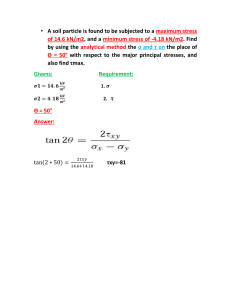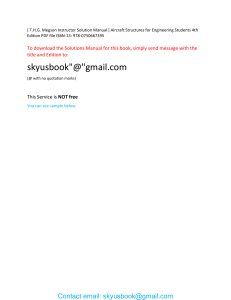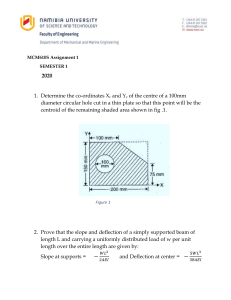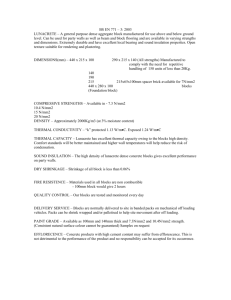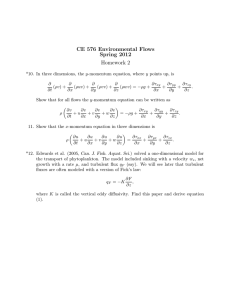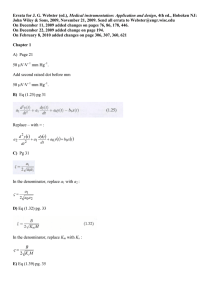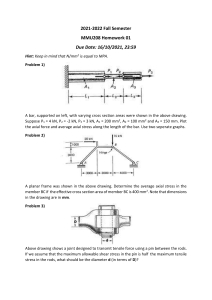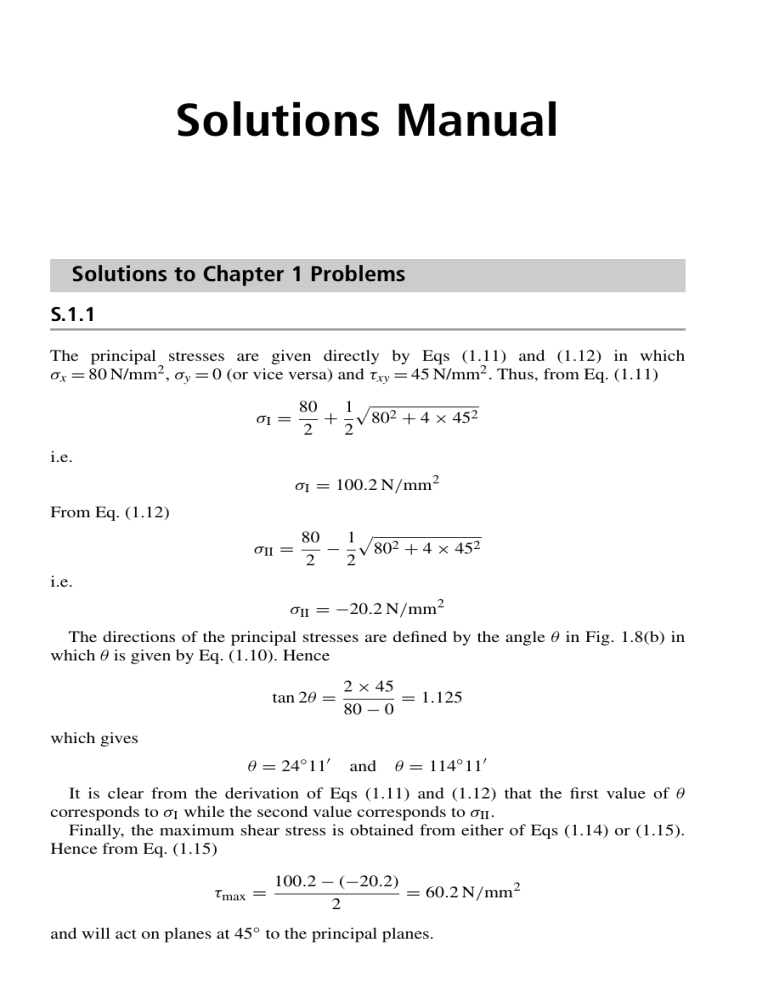
Solutions Manual Solutions to Chapter 1 Problems S.1.1 The principal stresses are given directly by Eqs (1.11) and (1.12) in which σx = 80 N/mm2 , σy = 0 (or vice versa) and τxy = 45 N/mm2 . Thus, from Eq. (1.11) σI = i.e. 80 1 2 80 + 4 × 452 + 2 2 σI = 100.2 N/mm2 From Eq. (1.12) σII = i.e. 80 1 2 80 + 4 × 452 − 2 2 σII = −20.2 N/mm2 The directions of the principal stresses are defined by the angle θ in Fig. 1.8(b) in which θ is given by Eq. (1.10). Hence tan 2θ = 2 × 45 = 1.125 80 − 0 which gives θ = 24◦ 11′ and θ = 114◦ 11′ It is clear from the derivation of Eqs (1.11) and (1.12) that the first value of θ corresponds to σI while the second value corresponds to σII . Finally, the maximum shear stress is obtained from either of Eqs (1.14) or (1.15). Hence from Eq. (1.15) τmax = 100.2 − (−20.2) = 60.2 N/mm2 2 and will act on planes at 45◦ to the principal planes. 4 Solutions Manual S.1.2 The principal stresses are given directly by Eqs (1.11) and (1.12) in which σx = 50 N/mm2 , σy = −35 N/mm2 and τxy = 40 N/mm2 . Thus, from Eq. (1.11) σI = i.e. 50 − 35 1 + (50 + 35)2 + 4 × 402 2 2 σI = 65.9 N/mm2 and from Eq. (1.12) σII = i.e. 50 − 35 1 − (50 + 35)2 + 4 × 402 2 2 σII = −50.9 N/mm2 From Fig. 1.8(b) and Eq. (1.10) tan 2θ = 2 × 40 = 0.941 50 + 35 which gives θ = 21◦ 38′ (σI ) and θ = 111◦ 38′ (σII ) The planes on which there is no direct stress may be found by considering the triangular element of unit thickness shown in Fig. S.1.2 where the plane AC represents the plane on which there is no direct stress. For equilibrium of the element in a direction perpendicular to AC 0 = 50AB cos α − 35BC sin α + 40AB sin α + 40BC cos α A α 50 N/mm2 τ B C 40 N/mm2 35 N/mm2 Fig. S.1.2 (i) Solutions to Chapter 1 Problems Dividing through Eq. (i) by AB 0 = 50 cos α − 35 tan α sin α + 40 sin α + 40 tan α cos α which, dividing through by cos α, simplifies to 0 = 50 − 35 tan2 α + 80 tan α from which tan α = 2.797 or −0.511 Hence α = 70◦ 21′ or −27◦ 5′ S.1.3 The construction of Mohr’s circle for each stress combination follows the procedure described in Section 1.8 and is shown in Figs S.1.3(a)–(d). Fig. S.1.3(a) Fig. S.1.3(b) 5 6 Solutions Manual Fig. S.1.3(c) Fig. S.1.3(d) S.1.4 The principal stresses at the point are determined, as indicated in the question, by transforming each state of stress into a σx , σy , τxy stress system. Clearly, in the first case σx = 0, σy = 10 N/mm2 , τxy = 0 (Fig. S.1.4(a)). The two remaining cases are transformed by considering the equilibrium of the triangular element ABC in Figs S.1.4(b), (c), (e) and (f). Thus, using the method described in Section 1.6 and the principle of superposition (see Section 5.9), the second stress system of Figs S.1.4(b) and (c) becomes the σx , σy , τxy system shown in Fig. S.1.4(d) while Solutions to Chapter 1 Problems 10 N/mm2 Fig. S.1.4(a) Fig. S.1.4(b) Fig. S.1.4(c) Fig. S.1.4(d) the third stress system of Figs S.1.4(e) and (f) transforms into the σx , σy , τxy system of Fig. S.1.4(g). Finally, the states of stress shown in Figs S.1.4(a), (d) and (g) are superimposed to give the state of stress shown in Fig. S.1.4(h) from which it can be seen that σI = σII = 15 N/mm2 and that the x and y planes are principal planes. 7 8 Solutions Manual Fig. S.1.4(e) Fig. S.1.4(f) Fig. S.1.4(g) Fig. S.1.4(h) S.1.5 The geometry of Mohr’s circle of stress is shown in Fig. S.1.5 in which the circle is constructed using the method described in Section 1.8. From Fig. S.1.5 σx = OP1 = OB − BC + CP1 (i) Solutions to Chapter 1 Problems τmax τ Q1 (σx, τxy) P2 O B (σI) σ C P1 Q2 (sy,⫺τxy) τmax Fig. S.1.5 In Eq. (i) OB = σI , BC is the radius of the circle which is equal to τmax and 2 2 . Hence − τxy CP1 = CQ12 − Q1 P12 = τmax σx = σI − τmax + Similarly 2 2 τmax − τxy σy = OP2 = OB − BC − CP2 in which CP2 = CP1 Thus σy = σI − τmax − 2 2 τmax − τxy S.1.6 From bending theory the direct stress due to bending on the upper surface of the shaft at a point in the vertical plane of symmetry is given by σx = 25 × 106 × 75 My = = 75 N/mm2 I π × 1504 /64 From the theory of the torsion of circular section shafts the shear stress at the same point is τxy = 50 × 106 × 75 Tr = = 75 N/mm2 J π × 1504 /32 9 10 Solutions Manual Substituting these values in Eqs (1.11) and (1.12) in turn and noting that σy = 0 σI = i.e. i.e. 75 1 2 75 + 4 × 752 + 2 2 σI = 121.4 N/mm2 75 1 2 σII = − 75 + 4 × 752 2 2 σII = −46.4 N/mm2 The corresponding directions as defined by θ in Fig. 1.8(b) are given by Eq. (1.10) i.e. 2 × 75 =2 tan 2θ = 75 − 0 Hence θ = 31◦ 43′ (σI ) and θ = 121◦ 43′ (σII ) S.1.7 The direct strains are expressed in terms of the stresses using Eqs (1.42), i.e. 1 [σx − ν(σy + σz )] E 1 εy = [σy − ν(σx + σz )] E 1 εz = [σz − ν(σx + σy )] E εx = Then e = εx + εy + εz = 1 [σx + σy + σz − 2ν(σx + σy + σz )] E i.e. e= (1 − 2ν) (σx + σy + σz ) E whence σ y + σz = Ee − σx (1 − 2ν) (i) (ii) (iii) Solutions to Chapter 1 Problems Substituting in Eq. (i) Ee 1 σx − ν − σx εx = E 1 − 2ν so that Eεx = σx (1 + ν) − Thus σx = νEe 1 − 2ν νEe E + εx (1 − 2ν)(1 + ν) (1 + ν) or, since G = E/2(1 + ν) (see Section 1.15) σx = λe + 2Gεx Similarly σy = λe + 2Gεy and σz = λe + 2Gεz S.1.8 The implication in this problem is that the condition of plane strain also describes the condition of plane stress. Hence, from Eqs (1.52) 1 (σx − νσy ) E 1 εy = (σy − νσx ) E εx = τxy 2(1 + ν) = τxy (see Section 1.15) G E The compatibility condition for plane strain is γxy = ∂2 γxy ∂2 εy ∂ 2 εx = + ∂x ∂y ∂x 2 ∂y2 (see Section 1.11) (i) (ii) (iii) (iv) Substituting in Eq. (iv) for εx , εy and γxy from Eqs (i)–(iii), respectively, gives 2(1 + ν) ∂2 τxy ∂2 ∂2 = 2 (σy − νσx ) + 2 (σx − νσy ) ∂x ∂y ∂x ∂y (v) 11 12 Solutions Manual Also, from Eqs (1.6) and assuming that the body forces X and Y are zero ∂τzy ∂σx + =0 ∂x ∂y ∂σy ∂τxy + =0 ∂y ∂x (vi) (vii) Differentiating Eq. (vi) with respect to x and Eq. (vii) with respect to y and adding gives ∂2 τxy ∂2 τxy ∂2 σy ∂2 σx + + + =0 ∂x 2 ∂y ∂x ∂y2 ∂x ∂y or ∂2 τxy ∂ 2 σy ∂ 2 σx 2 + =− ∂x ∂y ∂x 2 ∂y2 Substituting in Eq. (v) ∂2 σy ∂ 2 σx + −(1 + ν) ∂x 2 ∂y2 = ∂2 ∂2 (σy − νσx ) + 2 (σx − νσy ) 2 ∂x ∂y so that ∂ 2 σy ∂2 σx + −(1 + ν) ∂x 2 ∂y2 ∂2 σy ∂2 σy ∂2 σx ∂2 σx + −ν + = ∂x 2 ∂y2 ∂x 2 ∂y2 which simplifies to ∂2 σy ∂2 σy ∂ 2 σx ∂ 2 σx + + + =0 ∂x 2 ∂y2 ∂x 2 ∂y2 or ∂2 ∂2 + ∂x 2 ∂y2 (σx + σy ) = 0 S.1.9 Suppose that the load in the steel bar is Pst and that in the aluminium bar is Pal . Then, from equilibrium (i) Pst + Pal = P From Eq. (1.40) εst = Pst Ast Est εal = Pal Aal Eal Solutions to Chapter 1 Problems Since the bars contract by the same amount Pal Pst = Ast Est Aal Eal (ii) Solving Eqs (i) and (ii) Pst = Ast Est P Ast Est + Aal Eal Pal = Aal Eal P Ast Est + Aal Eal σal = Eal P Ast Est + Aal Eal from which the stresses are σst = Est P Ast Est + Aal Eal (iii) The areas of cross-section are Ast = π × 752 = 4417.9 mm2 4 Aal = π(1002 − 752 ) = 3436.1 mm2 4 Substituting in Eq. (iii) we have σst = σal = 106 × 200 000 = 172.6 N/mm2 (compression) (4417.9 × 200 000 + 3436.1 × 80 000) 106 × 80 000 = 69.1 N/mm2 (compression) (4417.9 × 200 000 + 3436.1 × 80 000) Due to the decrease in temperature in which no change in length is allowed the strain in the steel is αst T and that in the aluminium is αal T . Therefore due to the decrease in temperature σst = Est αst T = 200 000 × 0.000012 × 150 = 360.0 N/mm2 (tension) σal = Eal αal T = 80 000 × 0.000005 × 150 = 60.0 N/mm2 (tension) The final stresses in the steel and aluminium are then σst (total) = 360.0 − 172.6 = 187.4 N/mm2 (tension) σal (total) = 60.0 − 69.1 = −9.1 N/mm2 (compression). S.1.10 The principal strains are given directly by Eqs (1.69) and (1.70). Thus εI = 1 1 (−0.002 + 0.002) + √ (−0.002 + 0.002)2 + (+0.002 + 0.002)2 2 2 13 14 Solutions Manual i.e. εI = +0.00283 Similarly εII = −0.00283 The principal directions are given by Eq. (1.71), i.e. tan 2θ = 2(−0.002) + 0.002 − 0.002 = −1 0.002 + 0.002 Hence 2θ = −45◦ or +135◦ and θ = −22.5◦ or +67.5◦ S.1.11 The principal strains at the point P are determined using Eqs (1.69) and (1.70). Thus 1 1 2 2 εI = (−222 + 45) + √ (−222 + 213) + (−213 − 45) × 10−6 2 2 i.e. εI = 94.0 × 10−6 Similarly εII = −217.0 × 10−6 The principal stresses follow from Eqs (1.67) and (1.68). Hence σI = 31 000 (94.0 − 0.2 × 271.0) × 10−6 1 − (0.2)2 i.e. σI = 1.29 N/mm2 Similarly σII = −8.14 N/mm2 Since P lies on the neutral axis of the beam the direct stress due to bending is zero. Therefore, at P, σx = 7 N/mm2 and σy = 0. Now subtracting Eq. (1.12) from (1.11) σI − σII = 2 σx2 + 4τxy Solutions to Chapter 2 Problems i.e. 1.29 + 8.14 = 2 72 + 4τxy from which τxy = 3.17 N/mm2 . The shear force at P is equal to Q so that the shear stress at P is given by τxy = 3.17 = from which 3Q 2 × 150 × 300 Q = 95 100 N = 95.1 kN. Solutions to Chapter 2 Problems S.2.1 The stress system applied to the plate is shown in Fig. S.2.1. The origin, O, of the axes may be chosen at any point in the plate; let P be the point whose coordinates are (2, 3). 2p 4p y 4p P (2,3) 3p 3p x O 4p 4p 2p Fig. S.2.1 From Eqs (1.42) in which σz = 0 3p 2p 3.5p −ν =− E E E 2p 3p 2.75p εy = +ν = E E E εx = − (i) (ii) Hence, from Eqs (1.27) ∂u 3.5p =− ∂x E so that u = − 3.5p x + f1 (y) E (iii) 15
